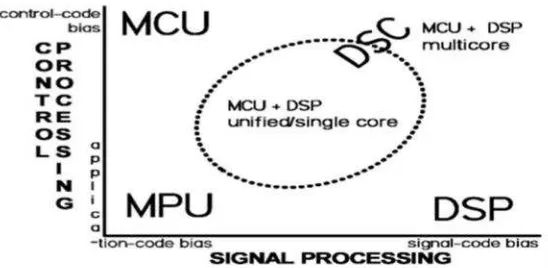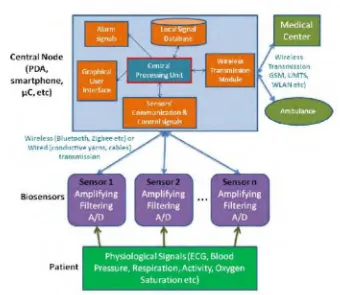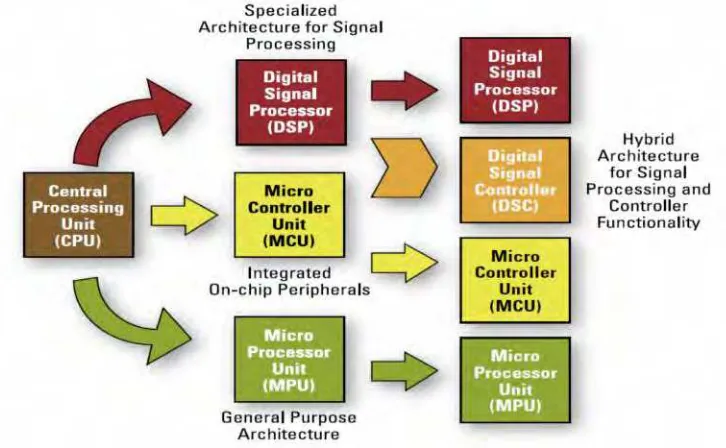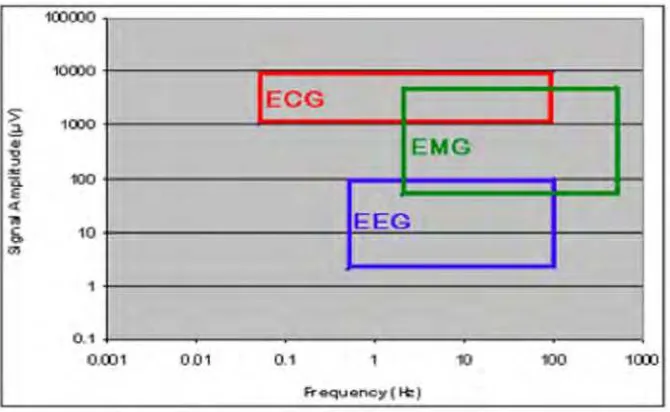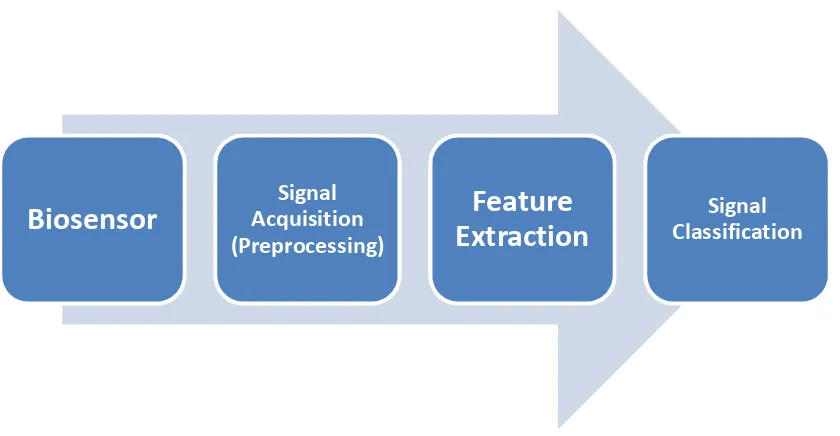PHYSIOLOGICAL USING FPGA IN HEALTH MONITORING SYSTEM
PROF. MADYA DR AHMAD JAMAL SALIM RADI HUSIN RAMLEE
DR SOO YEW GUAN
FAKULTI KEJURUTERAAN ELEKTRONIK DAN KEJURUTERAAN KOMPUTER UNIVERSITI TEKNIKAL MALAYSIA MELAKA
PJP/2011/FKEKK (20B)/S00854
PHYSIOLOGICAL USING FPGA IN HEALTH MONITORING SYSTEM
PROF. MADYA DR AHMAD JAMAL SALIM RADI HUSIN RAMLEE
DR SOO YEW GUAN
RESEACH VOTE NO.: PJP/2011/FKEKK (20B)/S00854
FAKULTI KEJURUTERAAN ELEKTRONIK DAN KEJURUTERAAN KOMPUTER UNIVERSITI TEKNIKAL MALAYSIA MELAKA
ABSTRACT
PHYSIOLOGICAL USING FPGA IN HEALTH MONITORING SYSTEM (Keywords: RISC, FPGA, Electromyography)
The reliability of health monitoring system always comprises its capability to perform accurate physiological data acquisition which is obtained from designated biosensors that are attached to a patient’s body. Proper digital signal processing techniques need to be executed efficiently on various stages such as noise cancellation, auto-correlation and filtering to achieve better signal quality. In this project, digital signal controller (DSC) is developed to deliver the capability of on-board signal processing power while at the same time provides integrated control mechanism to the overall health monitoring system. The DSC design includes a single chip solution approach which integrates RISC processor and DSP cores on a reconfigurable platform. A modified instruction set design is structured to perform signal processing tasks during the signal acquisition stage. The processed signals are stored on common memory module to be utilized by either a RISC processor or a DSP core for the next stages. Overall, the DSC is functioning as a robust sensor-reading platform that ensures reliable data acquisition through its signal processing tasks. Implementation of the DSC as a single-chip solution also has reduced the overall surface area by minimizing the number of components on-board.
CHAPTER 4 ...23
4.1 UTeMRISC02 Hierarchy ...23
4.1.1 CPU Module ...24
4.1.2 ROM and RAM Generation ...25
4.1.3 Instruction Decoder...25
4.1.4 Device Utilization Summary...26
4.1.5 FPGA Implementation Results ...27
4.2 EMG Signal Processing ...28
4.2.1 Raw SEMG Signal (Subject 1) ...28
4.2.2 MVC SEMG Signal ...29
4.2.3 Force of SEMG Signal ...29
4.2.4 MVC of Force ...30
4.3 FFT Feature Extraction ...31
4.3.1 FFT of SEMG Signal ...34
4.3.2 FFT of SEMG MVC ...37
4.4 Discussion ...38
CHAPTER 5 ...39
5.1 Conclusions...39
iv
Figure 5 EMG Signal Processing Flow ...11
Figure 6 UTeMRISC02 Architecture ...18
Figure 7 Shaj01pc Architecture ...21
Figure 8 UTeMRISC02 with MAC Instruction Extension...22
Figure 9 Design Hierarchy of UTeMRISC02...24
Figure 10 Device Utilization Summary of UTeMRISC02 Processor Core...26
Figure 11 ISim output result of MAC instruction implementation ...27
Figure 12 ChipScope output result of MAC instruction implementation...27
Figure 13 Raw EMG Signal ...28
Figure 19 Frequency Spectrum using Matlab FFT command ...32
Figure 20 Centered Spectrum ...33
Figure 21 Positive Side of Spectrum ...34
Figure 22 FFT on sEMG Signal ...35
Figure 23 FFT on last 100 window of sEMG Signal...35
Figure 25 FFT on sEMG Signal with Mean on Spectrum...37
CHAPTER 1
INTRODUCTION
Digital signal controller has been widely regards as the natural progression in
microprocessor evolutions. Starting with the CPU itself, microprocessor has been
evolved from basic computational functions to high-end, state-of-the-art architecture.
The progression of microelectronic and IC fabrication make the microprocessors more
popular as the ‘brain’ for various electronics gadgets and appliances. Since the last
two decades, microcontroller has been introduced, which physically combine the
microprocessor architecture with I/O peripheral and memory in a single integrated
chip.
On the other hand, digital signal processing (DSP) has been adapted to a
wide variety of applications because of demand in analog signal interfacing. As DSP
could be realized easily in a simulator, implementing DSP algorithms in hardware
platform is totally a different matter. The establishment of digital signal processor has
helped this cause but the DSP alone could not satisfy the whole package in making a
fully functional system. A hybrid of microcontroller and digital signal processor, also
known as digital signal controller (DSC), has been introduced and implemented with
several advantages (Bannatyne, 2003, Anant and Hutchings, 2005). Figure 1 shows
the variations of processor in accordance to its control processing and signal
Figure 1 Processor Type Variations
Conventional health monitoring system still requires several apparatus in
order to capture physiological signals from a human body to data logger. When
attached to a human body, bio-signal sensors then are fed to amplifier and filters to
provide a clean physiological signal. Then, analog-to-digital converter is needed in
order to pass the signal to a data logger or a PC for analysis or further signal
processing. During the whole data acquisition process, at least two devices are
required to perform the operation and these devices necessitate different power
requirement and cable connections. Therefore, there are rooms for improvement with
regards to minimizing the total board area of a data acquisition module which include
reducing the number of components without sacrificing the overall functionality and
reliability of signal acquisition in the health monitoring system.
1.1 Objectives
The study embarks on the following objectives:
a) To design data acquisition modules in a single-chip digital signal
controller to capture and log physiological signal data.
b) To assess the accuracy of the captured physiological signal to be
comparable with commercially available signal acquisition devices.
c) To evaluate and analyze performance of data acquisition process in
3
1.2 Problem Statement
The key research question for this proposal is “How single-chip design with
signal processing integration of digital signal controller would improve the accuracy
in data acquisition process in ahealth monitoring system?”
Biosensors are the main devices that feed the physiological inputs to the
monitoring system. Limitation due to its size and sensor positioning are factors that
influence the reliability of the measurements (Pantelopoulos and Bourbakis, 2010).
Although biosensors are integrated with amplifier and filter, signal filtering and
conditioning could be improved greatly with proper signal processing tasks perform
on-board by digital signal controller.
Human body is also susceptible to various anomalies that could affect the
accuracy of the physiological data transmitted. Signal noise in the form of sudden rise
in body temperature, moisture and humidity could disrupt the body signal and in turn
will jeopardize the diagnosis of the patients. A reliable digital signal controller would
provide the best mean in recognizing and filtering the unnecessary noise. Advanced
on-board DSP would also be able to correlate acquired measurement to recognize an
overall condition of thepatient’s health.
1.3 Project Scope
There are various stages involve in bio-signal processing flow and this
project is mainly focusing on the feature extraction process after physiological signals
are obtained from the biosensors. The entire project utilized electromyogram (EMG)
signal as the physiological signal for future project expansion with regards to EMG
signal processing and its related control application. On the other hand, the design and
development of DSC is targeting on the integration of an 8-bit RISC processor core
and DSP modules implemented in an FPGA platform. A signal processing task, i.e.
FFT, is implemented in the DSP core to identify the signal parameter during the
1.4 Report Overview
This report consists of five chapters where all chapters are essential to
describe the architecture and the functionality of the project.
Chapter 2 focused on the literature review of this project. It mainly explains
the two methods in the implementation of a reconfigurable system. Overview of
soft-core processors and instruction set customization are also addressed in this chapter.
Chapter 3 describes about the methodology of this project. All method to
achieve the result including simulation process is explained in details. Data
verification process is also clarified in this section.
Chapter 4 describes the result and discussion of the project. It covers all
analysis results of the project from simulation and hardware implementation.
Chapter 5 concludes about the knowledge that had been achieved during the
development of the project. Also the recommendation for future upgrades and
CHAPTER 2
LITERATURE REVIEW
As we advance to the next millennium, the world faces a new challenge,
which is the ageing society. With life expectancy is increased due to better lifestyle
and healthcare, the world population will be shared with higher percentage of senior
citizens. While the healthcare technology is constantly being developed to assist
senior citizens in continuing with their daily lives, it could not be the same with the
available healthcare infrastructure. The higher cost in setting up hospitals and the
rising prices of medication and prescription could lead to difficulties for the
community in having better treatment and healthcare services.
In view of this issue, health monitoring system is proposed to assist the
doctors by monitoring vital signs without the need for the patient to be there at the
hospital. The system will be attached to the patient body, continuously or at certain
period of time, to check the related physiological signal such as heart rate, ECG, etc.,
and early sign or warning of illness could be detected on the spot. Continuous
monitoring on the doctor’s behalf could easily be done using teleconference or by
internet connection. On some cases such as physiotherapy, treatment could also be
done to the patient remotely through what it is called as telemedicine. In the long run,
health monitoring system have only one purposes which is to provide a better
2.1 General Health Monitoring System
In general, health monitoring may comprise various types of miniature
sensors, wearable or even implantable. These biosensors are capable of measuring
significant physiological parameters like heart rate, blood pressure, body and skin
temperature, oxygen saturation, respiration rate and electrocardiogram (Pantelopoulos
and Bourbakis, 2010). Designing wearable systems involve numerous parameters to
satisfy with, including low power consumption, small size, and ergonomic and also
limited hardware specifications. Biosensors, on its own, only provide limited
analog-to-digital converter (A/D), filtering and amplifying due to its size and resource
limitation. While all the mentioned constraints make the system more complex, health
monitoring system still gaining a lot of attention from research community for the
past decade due to its cost saving and potential development of miniature biosensors,
IC design technology and reliable data transmission.
Basically, health monitoring system involved heavy signal processing on
physiological signal such as electrocardiography (ECG), blood pressure and oxygen
saturation. In certain cases, complex physiological signals such as
electroencephalography (EEG) and electromyography (EMG) signal is measured from
the patient body. For example, ECG signal monitoring is very critical for heart disease
patients in order to be able to detect early sign of heart failure. For rehabilitation
patient that require physiotherapy, EMG signal monitoring will ensure all related
muscle contraction, strain and fatigue could be identified by the patients themselves
or by their physiotherapist in real-time.
All physiological signals are obtained by the biosensors which are positioned
in conjunction with the source of the signals. To make the health monitoring system
ubiquitous and unobtrusive, the biosensors are manufactured in tiny packages to
minimize the circuit size. Advance MEMS technology has the capability to produce
miniature biosensors for various physiological signals. However, with little board
space and physical constraint on the circuit size, there are issues on the biosensor
accuracy and also its capability in doing more than data acquisition. Normally, the
accuracy of biosensors is related to the performance of the amplifier, filters and A/D
7
biosensor, some performance trade-off is inevitable in order to cramp all circuit
modules, plus wireless transmission module in the same board. Therefore, having the
single-chip system-on-chip (SoC) solution on the biosensors development is
recommended to balance the minimal size requirement of biosensors while
maintaining reliable measurement of physiological signal acquisition. Figure 2 shows
the block diagram of a general health monitoring system.
Figure 2 General Health Monitoring System
The biosensor itself is only responsible for the data acquisition process for
the health monitoring system. Resource-intensive operation such as signal processing,
feature extraction and signal classification could not be operated by biosensors alone
as it requires additional microcontroller (MCU) or digital signal processor (DSP) unit.
There is a variation of health monitoring system that utilize remote processing, where
the biosensors acquire the physiological data, transmit it to central node for minor
signal processing and then communicate with central server (located in hospitals or
medical centre) for further data processing or immediate action. This method will put
the burden of signal processing on to the powerful server and equipment ensuring
data transmission and data communication infrastructure. On the other hand,
localized processing is implemented by several health monitoring systems where the
signals are processed locally by the on-board DSP and communication with central
server only occurred when certain alarm or warning signs are triggered that indicate
the patient needed immediate attention. Localized processing provide a near real-time
indication of patient’s health condition although integrating the whole MCU, DSP and
filters and A/D on the same board will result in a bulky biosensor with undesirably
high power consumption. The development of biosensors on SoC platform has
minimized the component requirement while providing adequate signal processing
power to the biosensors.
2.2 Digital Signal Controller (DSC)
Single-chip solution for DSCs has been introduced by several big players in
DSCs, namely Microchip Inc., Analog Devices and Freescale Semiconductor.
However, most of the produced DSCs are the high-end processors (Salim et al.,
2008). With regards to health monitoring system, the advantage of combining RISC
processor core and DSP processor core provide a whole new opportunity in term of
signal acquisition, features extraction and classification. Figure 3 shows the other type
of controller that is based on CPU processing apart from DSC.
9
On-board signal processing also has been recognized as potential system
improvement in lowering the power consumption, hence smaller footprint and reduce
battery size and power requirement (Estrin et al., 2002, Celka et al., 2005).
Embedding sensor with pre-processing unit as suggested in (Acharyya et al., 2008)
has the potential in providing less surface area. However, normal signal processing
techniques need to be modified to suite the requirement of the targeted DSP
architecture.
Data reliability depends greatly on the capability of signal acquisition
architecture embedded on the DSC chip. At the same time, advanced signal
processing algorithm demands a lot of computational operation hence the requirement
of a stable power design architecture. The linkage between data reliability and low
power architecture need to be fully comprehended in order to provide satisfactory
signal analysis while maintaining an acceptable power consumption (Acharyya et al.,
2008).
2.3 EMG Signal Processing
Electromyography (EMG) is a technique for evaluating and recording the
electrical activity produced by skeletal muscles (Konrad, 2005) EMG is performed
using an instrument called an electromyograph, to produce a record called an
electromyogram. An electromyograph detects the electrical potential generated by
muscle cells (Perry, 1998) when these cells are electrically or neurologically
activated. The signals can be analysed to detect medical abnormalities, activation
level or to analyse the biomechanics of human. Figure 4 shows the effective
Figure 4 Physiological Signal Frequency Range
The EMG signal is the summation of the discharges of all the motor units
within the pick-up range of the electrode. During a sustained weak contraction, a
needle electrode might detect two motor units discharging independently at rates of
about ten discharges per second. The EMG signal will consist of two distinct trains of
motor unit action potentials (MUAPs). Most of the MUAPs will be clearly
recognizable. Occasionally, the two motor units may discharge at nearly the same
time, and the two MUAPs will overlap one another. This condition is called a
superposition. The resultant waveform can be either larger or smaller than the
individual MUAPs, depending on whether the overlap results in a constructive or
destructive interference.
Focus is given to surface electromyography (sEMG) signal due to its
potential end-user application in prosthesis or any control mechanism based on
muscle signalling. sEMG in health monitoring system is responsible to determine
health condition related to muscle activities, in particular musculoskeletal disorder
problem. sEMG signal classification also involves muscle fatigue estimation and
measurement of muscle recovery rate.
2.3.1 EMG Signal Processing Flow
Figure 5 shows the steps in EMG signal processing. Selection of feature
11
The success of pattern classification system depends on the choice of features used to
represent the raw signals (Han-Pang et al., 2003). Even though the raw EMG contains
important information of the muscle contraction it needs to be further processed in
order to extract its information (Konrad, 2005). The filtered raw signal will be further
processed with feature extraction which is an essential pre-process step for pattern
recognition. Two type of analysis will be performed for the feature extractions which
are amplitude and frequency analysis.
Figure 5 EMG Signal Processing Flow
The large amount of raw EMG data will be processed by performing FFT
analysis to acquire the information on the signals because it is impractical to use the
raw signal directly for classification as some information might be hidden in the
sequence of raw data. It is not valid to directly compare the EMG output of a muscle
across subjects because different subjects will have muscles with (Inman et al., 1952):
• different physiological cross-sections • different lengths - geometry
• different ratios of slow- to fast-twitch fibers • different recruitment patterns
• different firing frequencies
Biosensor
AcquisitionSignal (Preprocessing)Feature
Voluntary muscle contraction is the results of communication between the
individual muscle fibres of the musculoskeletal system and brain where a thought is
transformed into electrical impulses that travels down motor neurons (in the
peripheral and spine nerves) to the neuromuscular junctions that form a motor unit.
Individual muscle fibres within each motor unit contract either with all or none
response when stimulated which means that the muscle fibre is either contracting to
its maximum potential or none at all. Whole muscle contraction strength is dependent
on the number of individual fibres which are activated and capable of correlating with
the electrical activity measured over the muscle with an EMG sensor.
2.3.2 sEMG Signal Acquisition
In EMG measurement, the three main categories of electrodes used to record
EMG signals are needle electrodes, fine-wire electrodes, and surface electrodes.
Needle electrodes have the advantage that they can be manipulated within the muscle
to sample different parts of the muscle and to optimize signal characteristics.
Fine-wire electrodes are typically inserted with a hypodermic needle. The ends of the Fine-wires
remain in the muscle while the wires pass through the skin to connect to the amplifier.
One advantage of fine-wire electrodes is that it tends to remain in place well
throughout a long experiment.
Surface electrodes have the advantage that they are completely non-invasive,
but the limitation that they can only sample superficial muscles. Since surface
electrodes are far away from the muscle fibres, the MUAPs recorded are small in
amplitude and tend to look alike. To overcome this issue, electrode arrays are often
necessary in order to obtain decomposable signals.
2.3.3 Feature Extraction
In gesture recognition, feature extraction is a special form of dimensionality
reduction. This also helps to extract important information from the EMG signals.
When the input data to an algorithm is too large to be processed and it is suspected to
be redundant, then the input data will be transformed into a reduced representation set
13
extraction. The process of feature extraction helps the machine to learn the algorithm
quickly instead of just training the machine with bulky raw data which would have
made it computationally expensive.
Fast Fourier Transform (FFT) is used to determine the frequency spectrum of
the EMG signal. The frequency spectrum of the EMG signal is capable of detecting
muscle fatigue force production (Bigland-Ritchie et al., 1981). Before performing the
FFT, the raw signal will go through full wave rectification where all the negative
amplitudes are converted to positive amplitudes by moving up the negative spike of
the signal reflected by the baseline. Full wave rectified signals are easier to be read
and offer capability of applying standard amplitude parameters such as mean and peak
value to the signal curve (Konrad, 2005).
2.4 Processing Platform
DSP algorithms have been the heart of many sophisticated systems nowadays
due to the requirement of having large chunk of data that are needed to be processed
before any output could be produced. The most common DSP technique that is being
applied in various fields is Fast Fourier Transform (FFT). FFT and its variance have
been adopted especially in signal analysis in order to detect or identify certain features
of the signal that can be used as a unique input for the system. FFT also has the
capability to extract more information in frequency domain of a certain signals that
could benefit the system processing unit in order to come out with accurate feedback
and system’s output. Although FFT algorithm is considered capable in performing
adequate analysis during signal processing, further research and development has
introduced a slew of other algorithms that are derived from the FFT methodology. For
example the introduction of short-term FFT (STFT) is used to determine the
sinusoidal frequency and phase content of local sections of a signal as it changes over
time. In physiological signal analysis, wavelet transform is widely adopted as the
transformed signal provides information about the time and the frequency.
Incidentally, wavelet-transformation contains information similar to the
short-time-Fourier-transformation, but with additional special properties of the wavelets, which
Performance and accuracy of FFT-based transformation is dependant to
many type of factors such as the algorithm used, the selected radix-n and the total
sampling points. Different signals also required different type of FFT analysis and
parameters to produce optimized and persistent system’s output. Therefore, adopting
suitable FFT algorithm with matching characteristic of the input signals is vital in
order to develop an efficient DSP-based processing system.
The implementation of DSP-based system is divided into two types of
processing, which is an online processing and an off-line processing. DSP-based
system with an online processing basically performed all FFT algorithm and other
processing tasks on-site by using the hardware processor as the processor platform.
Usually, a processor that is capable in handling DSP algorithm is chosen to function
as the central processing unit of the system. All input signals are captured,
conditioned and directed to the processor to perform the necessary FFT tasks. Upon
completion of the signal analysis, appropriate outputs or feedbacks are channelled to
the associated output devices such as display monitors. In other perspective,
DSP-based system with an online processing capability could also be comprised of a
system that acted as the data collection or signal acquisition modules together with a
host server that is located off-site from the module vicinity. The signal acquired from
the module will be relayed to the host server for FFT computation, most likely
through telecommunication network such as 3G GSM or the networking Ethernet.
Once the server has completed the computation, the results will be relayed back to the
system for subsequent operations. With this type of configuration, the FFT processing
is executed in near real-time as certain delays are included during data transmission to
and from the host server. As comparison to the processor based system, having a host
server provided bigger performance advantage due to higher hardware specification of
the host server although the transmission delay is unavoidable and it also very
dependent towards the transmission network reliability.
An off-line processing is considered the conventional and low-cost method in
implementing a DSP-based hardware. In an off-line processing system, the signals
acquired from the signal acquisition modules are stored first in a designated memory
bank or a removable media. Once the capacity is full or after a certain time period has
15
system is normally applied to non-critical applications such as a data monitoring
system. The system implementation is simple and straight forward and the signal
CHAPTER 3
METHODOLOGY
The architecture of the proposed single-chip DSC includes a RISC processor
core, a DSP processor core, two ROMs for the RISC control program and the DSP
signal processing program and a common RAM for both RISC and DSP processor.
All are designed in one integrated chip while providing I/O interface to accommodate
all sensors and communication modules.
The RISC processor acts as the heart of the system where it controls and
synchronizes the I/O data according to the programmed operations. Input data from
sensors are put through the RISC processor first before being transferred to RAM
device. Assembled program of the RISC processor is stored in the ROM. The RISC
processor plays an essential part in the design as it permits analog-to-digital
conversion feature of the DSC. The RISC processor with a reduced instruction
command does make program development and code compilation more simplified.
The DSP processor core provides signal processing functionality, which is to
identify, filter, correlate and isolate raw data signals from noises and disturbance. The
capability to multiply and accumulate (MAC) in a normalized fixed-point arithmetic
would assist in providing clean data signals before being transmitted to the
17
of a RISC processor as well. Therefore another ROM device is needed to store
instruction command for the DSP processor.
With regards to single-chip solutions, the design of a RISC processor, a DSP
processor, communication modules and peripheral logics are to be described in
Verilog Hardware Description Language (HDL). These hardware blocks are to be
integrated and implemented using Field Programmable Gate Array (FPGA) chip. In
hardware design, logic synthesis and design verification process follows to determine
the accurate outcome of the data acquisition techniques. For software part, a RISC
processor program will be developed and debugged before being stored in ROM.
Hardware and software design are integrated and implemented in the FPGA chip.
A benchmarking process will commence to validate all physiological data
recorded by DSC with sample data obtained from commercially-of-the-shelf devices.
This is done to ensure all data obtained is dependable and consistent with
industrial-grade measurement equipment. Statistical analysis will be conducted to support the
validation results for any disparity. In the first half of the project timelines, a lot of
simulation is done in Xilinx Integrated Software Environment (ISE) to develop and
test Verilog codes for the microcontroller chip. Several modules are developed
including ALU, ROM, RAM, Special Function Registers, Stack and Instruction
Decoder. The latter half of the timelines is devoted to the downloading of the
processor design into Xilinx FPGA chip and testing it to perform as expected at
higher frequencies.
3.1 Overall Block Diagram
UTeMRISC02 processor utilized Harvard architecture where the memory
